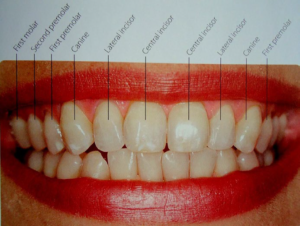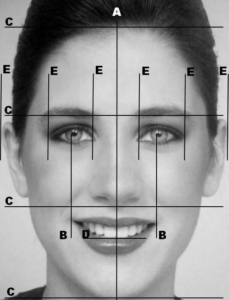Your smile plays a major role in how you perceive yourself, as well as in the impressions you make on the people around you. Surveys have shown that more than any other physical feature-eyes, hair or body-the smile is what both men and women find most attractive in other people. A charming smile can open doors and knock down barriers that stand between you and a fuller, richer life. If, on the other hand, you are dissatisfied with your smile, it may be holding you back from fully embracing life and its opportunities.
Perhaps you might be wondering whether straighter teeth might help you feel more confident in your professional life, or if a whiter, brighter smile might boost a dwindling social life.
If you’re not completely happy with your smile, it’s time to get a new one!
It all begins with your smile!!
What makes a Smile Beautiful?
Smile not only consists of front four or six teeth, but all of the teeth and the gum tissue that show when you’re speaking or when your lips are in your maximum smiling position. It’s important to know the components of a beautiful smile so that you can discuss your particular problems with the dentist and develop a treatment plan that meets your long-term goals.
Keep in mind that people don’t always look at you directly from the front. Consider the angles at which people are most likely to view you. For example, if you are short, most people look at you from above. Therefore, pay particular attention to your lower teeth, especially the biting edges. (Figure 1)
Figure 1: Smile analysis.

SMILE ANALYSIS
- Are the lengths of your Central Insisors in good proportion with your other front teeth?
A smile line is created by drawing an imaginary line along the biting edges of the upper teeth. The most youthful and appealing smile line is one in which the two central incisors Your smile looks older if the teeth are all the same length (a flat smile line) or if the central incisors are shorter than the lateral incisors or canines (a reverse smile line). If the lateral incisors are too short or the central incisors are too long, the curve is too pronounced and results in “Bunny look”.
Do you have a space (or Spaces) between your front teeth? Gaps between any of your front teeth, particularly between your central incisors, is a distraction in your smile.
- Do your Front Teeth Stick Out? Protruded teeth can cause facial deformity, not just an unappealing smile.
- Are your Front teeth Crowded or Overlapping? Crowded or Overlapping teeth detract from an otherwise attractive smile. Moreover, crooked teeth are difficult to clean, increasing the likelihood of gum disease, discolouration and even tooth loss.
- Is one of your Front teeth darker than the others? If one of your teeth is darker than the others, it may indicate that the nerve inside is injured or dead. In such cases, the tooth may require endodontic therapy.
- Do any of your teeth have visible cracks, chips or fractures? Cracks, Chips and Fractures can spoil an otherwise attractive smile. Also, cracks attract staining, making them even more visible.
- Do you have any missing teeth that you have not replaced? Missing teeth leaves holes that greatly detract from your smile. Even if the missing tooth is the back and not visible in your normal smile, it will cause teeth to shift, eventually causing gaps in the front teeth.
- When you smile broadly, do your gums show? Showing the gums above the teeth is referred to as a high lip line, and it can be attractive as long as the gum tissue is healthy looking. However, showing an excessive amount of gum tissue can ruin an otherwise attractive smile.
- Is the Shape of your teeth Appropriately Masculine or Feminine for your overall look?
Generally, square teeth are considered more masculine and rounded teeth more feminine. However, there are no rules. Some women want a delicate and more rounded shape to their teeth; some prefer a bold, athletic look. Likewise, many men desire an angular “masculine” smile, while others want a softer appearance.
DO YOU HAVE THE RIGHT PROPORTIONS?
Examine your own face in a mirror, making sure your hair is back so you can see your complete facial outline. Some asymmetry is expected and even desired-studies indicate that, within limits, the most appealing face is one with some sort of slight imbalance. However being aware of your own proportions is important as you begin to make decisions about changing your appearance. Changes to your smile can make a significant difference in the overall composition of your face.
ASSESSING YOUR FACIAL SYMMETRY
The Face is divided into halves vertically by line A, which is the midline. It should run through the centre of the nose and lips and ideally between the central incisors. Also the pupils off the eyes should align vertically with the corners of the mouth (lines B).
Horizontally, the face should divide into approximately equal thirds at the hairline, browline, base of the nose, and tip of the chin (lines C). The distance from the base of the nose to where the lips meet (line D) should be one-third of the lower third of the face. This face also meets the ancient Greek criterion of the perfect facial width, which is five times the width of one eye (line E). (Figure 2)
Figure 2: Assessing your facial symmetry.

SMILE CORRECTION
Treatment options:
• Cosmetic Contouring: Cosmetic Contouring, or reshaping the natural teeth to create an illusion of straightness, can sometimes be the easiest way to correct problems associated with poor bites, particularly in cases of minor crowding or uneven tooth lengths.
• Bonding: Bonding along with cosmetic contouring, can be used to build out the upper teeth and reshape the lower teeth so that they are in improved relationship. However bonding is weak compromise treatment most times.
• Porcelain Veeners: Porcelain veneers provides a more esthetic option compared with bonding. The advantage is the proportional accuracy that they provide. This technique is especially effective when spaces are not uniform. Another reason to choose porcelain veneers is that they will not stain nearly as much as bonded restorations.
• Crowns: Crowns are the choice of treatment if the teeth are badly damaged and require major changes in the shape or alignment of teeth. Placement of crows require considerable amount of reduction of natural tooth structure.
• Fixed Bridges: Also called Fixed Partial Dentures are used to replace missing teeth. They are attached to neighbouring teeth and cemented into place. The underlying substructure can be made of a ceramic material or metal, but the restorations are typically porcelain.
• Conventional Fixed Bridges-A beautiful esthetic result can be achieved with a conventional fixed bridge because teeth needed to anchor the bridge on either side of the missing teeth are made into crowns and no metal shows. However there must be sufficient room for porcelain between the upper and lower teeth when replacing a missing tooth with a fixed bridge.
• Resin Bonded Fixed Bridge-Also called as Maryland Bridge. The replacement tooth or teeth are attached to a metal framework that is bonded to adjacent teeth with resin cement. If the teeth adjacent to the missing tooth are intact and in good condition, this type of restoration may be a good choice. If there are cosmetic problems with the adjacent teeth, however a conventional bridge should be considered.
• Removable Bridges: Also called Removable Partial Dentures which replace missing teeth and gum tissue and are attached to neighbouring teeth. However they are not cemented to a place and therefore can be removed.
• Complete Denture: It is a removable denture which replaces all of the teeth in an arch as well as any missing supporting structures (gums and bone).
• Implants: Dental Implant is a metal or ceramic device that replaces the root of the natural tooth. After implants are placed in the bone, artificial teeth are attached to them, enabling normal function and natural tooth appearance.
The treatment options described above depends upon every individual and the underlying problem. Dentistry’s role in improving appearance is often misunderstood and underrated. For example, many people believe that only dentures can alter the appearance of their smile, yet nothing could be further from the truth. Such cost effective techniques as cosmetic contouring, bleaching or bonding often work wonders.
10 Tips to keep your smile young
1. Watch for unnatural wear and avoid grinding your teeth.
2. Take preventive oral hygiene seriously to avoid gum and bone loss.
3. Replace faulty fillings before they cause problems.
4. If crowns or bridges are worn down, replace them.
5. Lighten any discoloured teeth.
6. Replace any missing teeth as soon as possible.
7. Correct a bad bite.
8. Never chew ice or hard candy or suck on lemons.
9. Consume less Tea/Coffee as they tend to stain your teeth.
10 Avoid abrasive habits such as aggressive tooth brushing.
Never stop caring!
As they get older, some people stop taking proper care of them, including their teeth. Remember that it’s never too late to start taking care of yourself again. You feel better with updated smile and look much younger. This could tremendously help in improving not only your appearance but also your outlook on life.







